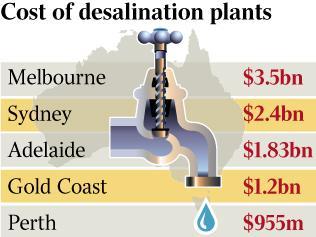Water charges are set to spiral in desalination squeeze
HOUSEHOLDS will pay hundreds of dollars extra for water as state governments splash $9 billion of taxpayer funds on energy-guzzling desalination plants.

HOUSEHOLDS will pay hundreds of dollars extra for water as state governments splash $9 billion of taxpayer funds on energy-guzzling desalination plants that will produce nearly a third of capital-city supplies within two years.
The seawater purification "factories" - which can pump out enough drinking water each year to fill Sydney Harbour - will operate around the clock at taxpayer expense, even when high rainfall means their expensive output is not required.
Water utilities yesterday warned urban water prices would spiral in line with the rising cost of electricity needed to operate the massive plants in Sydney, Adelaide, Perth, Melbourne and the Gold Coast.
The Water Services Association of Australia, representing most of the urban water utilities nationally, estimated water providers would use up to four times as much electricity as they moved from dams to desalination.
"The cost of building desalination plants will be reflected in water prices across Australia," executive director Ross Young told The Weekend Australian.
"Electricity prices are only going to go upwards, so operational costs are probably going to climb steadily.
"In places like Melbourne in the next four years (water) prices are going to double."
By 2012, water bills for Sydneysiders will rise $103 a year purely to pay for the cost of running the city's first desalination plant, costing $2.4bn, due to open at Kurnell within weeks.
Household water bills will soar nearly a third - from $663 to $904 - in the Melbourne metropolis over the next three years, once a $3.5bn plant - the nation's biggest - comes online at the end of next year.
In southeast Queensland, where a $1.2bn desalination plant opened on the Gold Coast last year, water bills are forecast to rise about $60 annually until 2013.
In Adelaide, where a $1.83bn plant will open at the end of next year, water bills will increase $84 this year for an average household.
In Perth, which will open its second plant next year, the average household water bill will rise 10 per cent over the next three years, costing high-use households as much as $164 a year more.
Mr Young said higher bills would give consumers an incentive to save water.
"Any resource given away free is always exploited," he said. "If water is priced too low there's no incentive for conservation or to upgrade infrastructure.
"We shouldn't underestimate the power of a price signal."
CSIRO urban water research division leader Alan Gregory said electricity made up a quarter of the total cost of building and running a desalination plant.
"Just the energy component alone will drive up the cost of water," he said. "You haven't got to be Einstein to work out that prices will go up. It's unavoidable."
A CSIRO analysis for the Water Services Association has found that desalination plants use seven times more electricity than conventional water treatment plants.
The research reveals that energy consumption by water utilities would rise 400 per cent if they switched entirely to desalination for city water supplies within 20 years.
Energy use would soar by 260 per cent if utilities sourced 40 per cent of their water from the ocean.
The National Water Commission has calculated that the running costs of a typical desalination plant would jump 16 per cent if an emissions trading scheme is introduced that prices carbon at $50 a tonne.
Critics of the states' massive investment in desalination yesterday dismissed the technology as "financially risky".
Stuart White, the director of the Institute for Sustainable Futures, at the University of Technology, Sydney, said the desalination plants roped taxpayers and consumers into paying for water that might not always be necessary.
"Once you build them, there's the imperative to operate them," Mr White said yesterday.
"Sometimes (it's) a contractual imperative . . . flat-out."
In Sydney, where dams are now half-empty, the new Kurnell plant will run at full capacity for at least two years, regardless of rainfall levels.
Operators of the desalination plants are trying to douse the debate over greenhouse gas emissions by buying "green power" from sources such as wind farms. But in Western Australia, the government pricing watchdog has vetoed the Water Corporation's plan to charge its consumers the extra cost of buying more expensive experimental green electricity to power Perth's desalination plants.
The West Australian Economic Regulation Authority's chairman, Lyndon Rowe, said yesterday the role of the Water Corporation was to "provide water to consumers at the least possible cost".
"If a government itself wants to sponsor the research (into renewable energy) it's fine, but it shouldn't be a cost borne by water users," he said.
Mr Rowe likened desalination plants to "water factories".
"We can produce all the water you like but it can't be free," Mr Rowe said.
"It should be paid for by the users, to encourage people to use water wisely."



